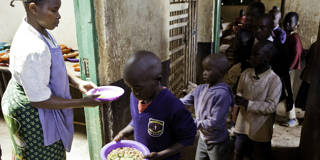Policymakers and global aid organizations tend to draw an artificial boundary between a child’s education and overall well-being. But reducing learning poverty requires addressing the complex barriers – like inadequate nutrition – that prevent children in poor countries from realizing their academic potential.
LONDON – There is growing concern that children in developing countries are not learning enough in school. Even before pandemic-related school closures, 57% of ten-year-olds in low- and middle-income countries were unable to read and understand a simple text – the definition of “learning poverty.” The COVID-19 crisis has only exacerbated the situation, leading large donors and global institutions to launch a program aimed at improving foundational skills.
But if well-intentioned efforts to tackle learning poverty do not account for the complex and interrelated challenges that prevent children in poor countries from achieving academic success, they risk reproducing existing inequalities in educational outcomes.
For the more than one billion children worldwide who live in multidimensional poverty – lacking access to adequate nutrition, health care, safety, and sanitation – the barriers to learning extend far beyond the school gates. They may suffer from the psychological stresses of poverty or be hungry at school, both of which impede learning. Perhaps violence threatens them inside or outside the classroom, or they are at risk of being married off young and dropping out of school. Overreliance on technical solutions designed to address the proximate causes of learning poverty from the supply side could leave many of these children behind.

LONDON – There is growing concern that children in developing countries are not learning enough in school. Even before pandemic-related school closures, 57% of ten-year-olds in low- and middle-income countries were unable to read and understand a simple text – the definition of “learning poverty.” The COVID-19 crisis has only exacerbated the situation, leading large donors and global institutions to launch a program aimed at improving foundational skills.
But if well-intentioned efforts to tackle learning poverty do not account for the complex and interrelated challenges that prevent children in poor countries from achieving academic success, they risk reproducing existing inequalities in educational outcomes.
For the more than one billion children worldwide who live in multidimensional poverty – lacking access to adequate nutrition, health care, safety, and sanitation – the barriers to learning extend far beyond the school gates. They may suffer from the psychological stresses of poverty or be hungry at school, both of which impede learning. Perhaps violence threatens them inside or outside the classroom, or they are at risk of being married off young and dropping out of school. Overreliance on technical solutions designed to address the proximate causes of learning poverty from the supply side could leave many of these children behind.